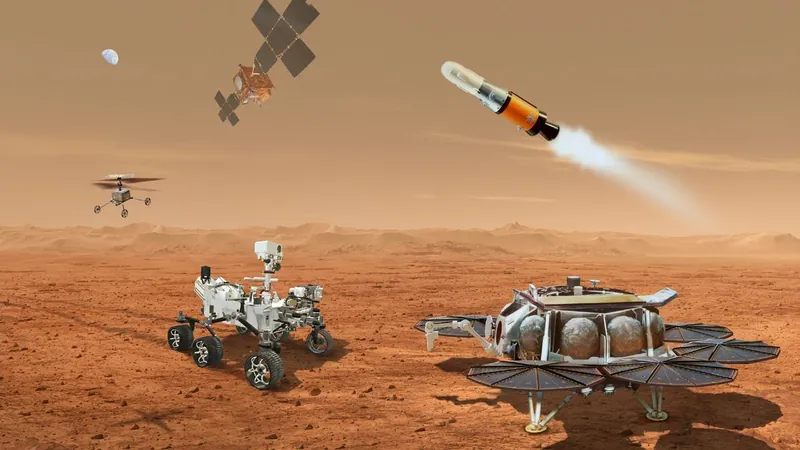
Is NASA's Mars Sample Return Mission on the Brink of Collapse?
2025-01-03
Author: Rajesh
Introduction
As it stands, a fierce unofficial robotic space race is brewing, with both the United States and China vying to bring tantalizing samples from Mars back to Earth through their respective Mars Sample Return (MSR) missions.
NASA's Perseverance Rover and Challenges
In the United States, NASA's Perseverance rover is actively traversing Jezero Crater, diligently collecting Martian soil and rock samples for a future MSR mission. However, the agency is grappling with significant challenges; the anticipated cost of the MSR mission has skyrocketed to over $11 billion, and NASA has projected that samples won't arrive on Earth until at least 2040. This timeline has elicited concerns and dissatisfaction from NASA leadership, prompting urgent evaluations of how to cut costs and accelerate sample return.
Mars Sample Return Strategy Review Team
Enter the Mars Sample Return (MSR) Strategy Review Team, led by MIT planetary scientist Maria Zuber. This independent committee is currently surveying findings from various studies by industry experts, NASA centers, and leading laboratories such as the Jet Propulsion Laboratory and the Johns Hopkins Applied Physics Laboratory. Their task is to evaluate whether NASA's ambitious Mars Sample Return project can still be salvaged and to provide a cohesive strategy, including cost and schedule assessments.
Future of the MSR Mission
NASA has indicated that the findings from Zuber and her team will be disclosed soon, potentially leading to further Mars Sample Return program updates by early 2025. The central question looms: How can America’s Mars Sample Return aspirations not just survive, but thrive against mounting challenges?
China's Tianwen-3 Mission
Meanwhile, China's ambitions loom large with its Tianwen-3 mission, which aims for Mars sample retrieval by around 2031. A recent research paper outlines that the Tianwen-3 mission will consist of two launches taking place around 2028, further complicating the competitive landscape of Mars exploration. Chinese scientists, led by the mission's chief scientist Hou Zengqian, are meticulously evaluating potential sampling sites on Mars and strategizing how to analyze the materials brought back.
Expert Opinions and Recommendations
As discussions continue among experts and stakeholders within NASA’s Mars Exploration Program Analysis Group (MEPAG), a consensus is emerging. MEPAG emphasizes that the MSR mission should focus on carefully selected samples to answer multifaceted questions about Mars, rather than resorting to a "grab bag" approach that risks diluting scientific value. This observation draws from historical lessons learned, particularly from the 1997 Mars Pathfinder mission, which illuminated the pitfalls of indiscriminately gathered samples without sufficient context.
Quality over Quantity
Bruce Jakosky, a senior research scientist at the University of Colorado, points out the profound difference between the meticulously chosen samples collected by Perseverance versus any random samples that might be gathered. He asserts that the quality and scientific utility of the samples will be paramount, regardless of whether the Chinese mission proceeds ahead of NASA’s.
Conclusion
As the clock ticks and competition heats up, the scientific community is left anxiously watching to see if NASA can rejuvenate its Mars Sample Return mission or if it will face an uphill battle against China’s rapidly advancing plans. With the stakes higher than ever, one thing is clear: the race to Mars is just beginning, and its outcome could reshape our understanding of the Red Planet for generations to come.
 Brasil (PT)
Brasil (PT)
 Canada (EN)
Canada (EN)
 Chile (ES)
Chile (ES)
 Česko (CS)
Česko (CS)
 대한민국 (KO)
대한민국 (KO)
 España (ES)
España (ES)
 France (FR)
France (FR)
 Hong Kong (EN)
Hong Kong (EN)
 Italia (IT)
Italia (IT)
 日本 (JA)
日本 (JA)
 Magyarország (HU)
Magyarország (HU)
 Norge (NO)
Norge (NO)
 Polska (PL)
Polska (PL)
 Schweiz (DE)
Schweiz (DE)
 Singapore (EN)
Singapore (EN)
 Sverige (SV)
Sverige (SV)
 Suomi (FI)
Suomi (FI)
 Türkiye (TR)
Türkiye (TR)
 الإمارات العربية المتحدة (AR)
الإمارات العربية المتحدة (AR)